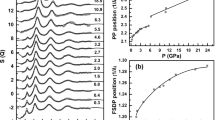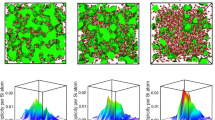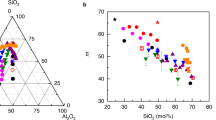Abstract
Amorphous–amorphous transformations under pressure are generally explained by changes in the local structure from low- to higher-fold coordinated polyhedra1,2,3,4. However, as the notion of scale invariance at the critical thresholds has not been addressed, it is still unclear whether these transformations behave similarly to true phase transitions in related crystals and liquids. Here we report ab initio-based calculations of compressed silica (SiO2) glasses, showing that the structural changes from low- to high-density amorphous structures occur through a sequence of percolation transitions. When the pressure is increased to 82 GPa, a series of long-range (‘infinite’) percolating clusters composed of corner- or edge-shared tetrahedra, pentahedra and eventually octahedra emerge at critical pressures and replace the previous ‘phase’ of lower-fold coordinated polyhedra and lower connectivity. This mechanism provides a natural explanation for the well-known mechanical anomaly around 3 GPa, as well as the structural irreversibility beyond 10 GPa, among other features. Some of the amorphous structures that have been discovered mimic those of coesite IV and V crystals reported recently5,6, highlighting the major role of SiO5 pentahedron-based polyamorphs in the densification process of vitreous silica. Our results demonstrate that percolation theory provides a robust framework to understand the nature and pathway of amorphous–amorphous transformations and open a new avenue to predict unravelled amorphous solid states and related liquid phases7,8.
This is a preview of subscription content, access via your institution
Access options
Access Nature and 54 other Nature Portfolio journals
Get Nature+, our best-value online-access subscription
$29.99 / 30 days
cancel any time
Subscribe to this journal
Receive 51 print issues and online access
$199.00 per year
only $3.90 per issue
Buy this article
- Purchase on Springer Link
- Instant access to full article PDF
Prices may be subject to local taxes which are calculated during checkout



Similar content being viewed by others
Data availability
Figures and corresponding datasets (agr format), as well as sample trajectories at selected pressures are available at Zenodo (https://doi.org/10.5281/zenodo.5056541).
Code availability
The DFTB+ code is publicly available at https://dftbplus.org/. Additional information may be found there. The percolation code is available freely for non-commercial research at Zenodo (https://doi.org/10.5281/zenodo.5064069). Other codes for structural characterization are available from B.H.
References
McMillan, P. F., Wilson, M., Daisenberger, D. & Machon, D. A density-driven phase transition between semiconducting and metallic polyamorphs of silicon. Nat. Mater. 4, 680–684 (2005).
Sheng, H. W. et al. Polyamorphism in a metallic glass. Nat. Mater. 6, 192–197 (2007).
Prescher, C. et al. Beyond 6-fold coordinated Si in SiO2 glass at ultrahigh pressures. Proc. Natl Acad. Sci. USA 114, 10041–10046 (2017).
Deringer, V. L. et al. Origins of structural and electronic transitions in disordered silicon. Nature 589, 59–64 (2021).
Hu, Q. Y. et al. Polymorphic phase transition mechanism of compressed coesite. Nat. Commun. 6, 6630 (2015).
Bykova, E. et al. Metastable silica high pressure polymorphs as structural proxies of deep Earth silicate melts. Nat. Commun. 9, 4789 (2018).
Debenedetti, P. G. & Stillinger, F. H. Supercooled liquids and the glass transition. Nature 410, 259–267 (2001).
Loerting, T., Brazhkin, V. V. & Morishita, T. Multiple amorphous–amorphous transitions. Adv. Chem. Phys. 143, 29–82 (2009).
Brazhkin, V. V., Lyapin, A. G. & Trachenko, K. Atomistic modeling of multiple amorphous–amorphous transitions in SiO2 and GeO2 glasses at megabar pressures. Phys. Rev. B 83, 132103 (2011).
Lin, J.-F. et al. Electronic bonding transition in compressed SiO2 glass. Phys. Rev. B 75, 012201 (2007).
Zeidler, A. et al. High pressure transformation of SiO2 glass from a tetrahedral to an octahedral network: a joint approach using neutron diffraction and molecular dynamics. Phys. Rev. Lett. 113, 135501 (2014).
Ryuo, E., Wakabayashi, D., Koura, A. & Shimojo, F. Ab initio simulation of permanent densification in silica glass. Phys. Rev. B 96, 054206 (2017).
Tsiok, O. B., Brazhkin, V. V., Lyapin, A. G. & Khvostantsev, L. G. Logarithmic kinetics of the amorphous–amorphous transformations in SiO2 and GeO2 glasses under high pressure. Phys. Rev. Lett. 80, 999–1002 (1998).
Weigel, C. et al. Pressure-induced densification of vitreous silica: insight from elastic properties. Phys. Rev. B 100, 094102 (2019).
Trachenko, K., Dove, M. T., Brazhkin, V. & El’kin, F. S. Network rigidity and properties of SiO2 and GeO2 glasses under pressure. Phys. Rev. Lett. 93, 135502 (2004).
Liang, Y., Miranda, C. R. & Scandolo, S. Mechanical strength and coordination defects in compressed silica glass: molecular dynamics simulations. Phys. Rev. B 75, 024205 (2007).
Sarnthein, J., Pasquarello, A. & Car, R. Origin of the high-frequency doublet in the vibrational spectrum of vitreous SiO2. Science 275, 1925–1927 (1997).
Hosokawa, S. et al. Oxygen 2p partial density of states and bond angles around O atoms in SiO2 glass. J. Phys. Soc. Jpn 84, 024605 (2015).
Wu, M., Liang, Y., Jiang, J.-Z. & Tse, J. S. Structure and properties of dense silica glass. Sci. Rep. 2, 398 (2012).
Murakami, M. et al. Ultrahigh-pressure form of SiO2 glass with dense pyrite-type crystalline homology. Phys. Rev. B 99, 045153 (2019).
Harvey, J. P. & Asimow, P. D. Current limitations of molecular dynamic simulations as probes of thermo-physical behavior of silicate melts. Am. Min. 100, 1866–1882 (2015).
Kob, W. & Ispas, S. in Encyclopedia of Glass Science, Technology, History, and Culture (ed. Richet, P.) Ch. 2.9 (Wiley, 2020).
Aradi, B., Hourahine, B. & Frauenheim, T. DFTB+, a sparse matrix-based implementation of the DFTB method. J. Phys. Chem. A 111, 5678–5684 (2007).
Pauling, L. The principles determining the structure of complex ionic crystals. J. Am. Chem. Soc. 51, 1010–1026 (1929).
Sato, T. & Funamori, N. High pressure structural transformation of SiO2 glass up to 100 GPa. Phys. Rev. B 82, 184102 (2010).
Phillips, J. C. & Thorpe, M. F. Constraint, vector percolation and glass formation. Solid State Commun. 53, 699–702 (1985).
Sauffer, D. & Aharony, A. Introduction to Percolation Theory (Taylor & Francis, 2003).
Hu, Q. Y. et al. Stability limits and transformation pathways of α-quartz under high pressure. Phys. Rev. B 95, 104112 (2017).
Pabst, W. & Gregorová, E. Elastic properties of silica polymorphs—a review. Ceramics Silikáty 57, 167–184 (2013).
Machon, D., Meersman, F., Wilding, M. C., Wilson, M. & McMillan, P. F. Pressure-induced amorphization and polyamorphism: inorganic and biochemical systems. Prog. Mater. Sci. 61, 216–282 (2014).
Brovchenko, I. & Oleinikova, A. Multiple phases of liquid water. ChemPhysChem 9, 2660–2675 (2008).
Yang, X., Tong, H., Wang, W. H. & Chen, K. Emergence and percolation of rigid domains during the colloidal glass transition. Phys. Rev. E 99, 062610 (2019).
Ojovan, M. I. & Louzguine-Luzgin, D. V. Revealing structural changes at glass transition via radial distribution functions. J. Phys. Chem. B 124, 3186–3194 (2020).
Tong, H., Sengupta,S. & Tanaka, H. Emergent solidity of amorphous materials as a consequence of mechanical self-organisation. Nat. Commun. 11, 4863 (2020).
Trave, A., Tangney, P., Scandolo, S., Pasquarello, A. & Car, R. Pressure-induced structural changes in liquid SiO2 from ab initio simulations. Phys. Rev. Lett. 89, 245504 (2002).
Karki, B. B., Bhattarai, D. & Stixrude, L. First-principles simulations of liquid silica: structural and dynamical behavior at high pressure. Phys. Rev. B 76, 104205 (2007).
Zhu, X. F. & Chen, L. F. First-principles molecular dynamics simulations of the structure of germanium dioxide under pressures. Phys. B 404, 4178–4184 (2009).
Gartner, T. E. III, Torquato, S., Car, R. & Debenedetti, P. G. Manifestations of metastable criticality in the long-range structure of model water glasses. Nat. Commun. 12, 3398 (2021).
Carré, A., Berthier, L., Horbach, J., Ispas, S. & Kob, W. Amorphous silica modeled with truncated and screened Coulomb interactions: a molecular dynamics simulation study. J. Chem. Phys. 127, 114512 (2007).
Koehler, C., Hajnal, Z., Deak, P., Frauenheim, T. & Suhai, S. Theoretical investigation of carbon defects and diffusion in α-quartz. Phys. Rev. B 64, 085333 (2001).
Zwijnenburg, M. A., van Alsenoy, C. & Maschmeyer, T. Factors affecting ionicity in all-silica materials: a density functional cluster study. J. Phys. Chem. A 106, 12376–12385 (2002).
Gibbs, G. V. et al. Bonded interactions in silica polymorphs, silicates and siloxane molecules. Am. Min. 94, 1085–1102 (2009).
Binder, K. & Kob, W. Glassy Materials and Disordered Solids (Word Scientific, 2005).
Neutron Scattering Lengths and Cross Sections (NIST Center for Neutron Research, 2021); https://www.ncnr.nist.gov/resources/n-lengths/
Fischer, H. E., Barnes, A. C. & Salmon, P. S. Neutron and X-ray diffraction studies of liquids and glasses. Rep. Prog. Phys. 69, 233–299 (2006).
Waasmaier, D. & Kirfel, A. New analytical scattering-factor functions for free atoms and ions for free atoms and ions. Acta Crystallogr. A51, 416–431 (1995).
More, S., Andrey, V., Kravtsov, A. V., Dalal, N. & Gottlöber, S. The overdensity and masses of the friends-of-friends halos and universality of halo mass function. Astrophys. J. Suppl. Ser. 195, 4 (2011).
Zha, C.-S., Hemley, R. J., Maom, H.-K., Duffy, T. S. & Meade, C. Acoustic velocities and refractive index of SiO2 glass to 57.5 GPa by Brillouin scattering. Phys. Rev. B 50, 13105–13112 (1994).
Petitgirard, S. et al. SiO2 glass density to lower-mantle pressures. Phys. Rev. Lett. 119, 215701 (2017).
American Mineralogist Crystal Structure Database (AMCSD, 2021); http://rruff.geo.arizona.edu/AMS/amcsd.php
Yi, Y. S. & Lee, K. L. Pressure-induced changes in local electronic structures of SiO2 and MgSiO3 polymorphs: insights from ab initio calculations of O K-edge energy-loss near-edge structure spectroscopy. Am. Min. 97, 897–909 (2012).
Scheidl, K. S., Kurnosov, A., Boffa Ballaran, D. M., Angel, R. J., & Miletich, R. Extending the single-crystal quartz pressure gauge up to hydrostatic pressure of 19 GPa, J. Appl. Crystallogr. 49, 2129–2137 (2016).
Buchen, J. et al. Equation of state of polycrystalline stishovite across the tetragonal–orthorhombic phase transition. J. Geophys. Res. Solid Earth 123, 7347–7360 (2018).
Hasmy, A., Foret, M., Pelous, J., & Jullien, R. Small-angle neutron-scattering investigation of short-range correlations in fractal aerogels: simulations and experiments. Phys. Rev. B 48, 9345–9353 (1993).
O’Keeffe M. & Hyde B. G. in Structure and Bonding in Crystals (eds O’Keeffe, M. & Navrotsky, A.) 227–254 (Academic, 1981).
Kono, Y., Shu, Y., Kenney-Benson, C., Wang, Y., & Shen, G. Structural evolution of SiO2 glass with Si coordination number greater than 6. Phys. Rev. Lett. 125, 205701 (2020).
Acknowledgements
We thank the BioNano-NMRI team (L2C, UM) for computer facilities. A.H. thanks the CNRS (France) for funding, L. C. Rincón for introducing him to the SCC-DFTB method and E. Anglaret and F. Piuzzi for support that enabled him to participate in the conception of this project. This work was granted access to the high-performance computing resources of CINES by GENCI (Grand Equipement National de Calcul Intensif) under allocation grants nos. A0060910788, A0080910788 and A0100910788. BH acknowledges support from the French National Research Agency program PIPOG ANR-17-CE30-0009.
Author information
Authors and Affiliations
Contributions
All authors initiated the project. A.H. and B.H. performed the MD tight-binding (SCC-DFTB) calculations of the pressurized glasses, after S.I. prepared the initial glass at ambient pressure by classical MD simulations. A.H. performed the tight-binding calculations of the crystals and computed the percolation tools. All authors contributed to data analysis: atomic structure (A.H., B.H. and S.I.), electronic structure and percolation (A.H.) and inelastic structure factors (S.I.). A.H. and B.H. developed the main conclusions and wrote the paper. S.I. contributed to the final version of the paper.
Corresponding authors
Ethics declarations
Competing interests
The authors declare no competing interests.
Additional information
Peer review information Nature thanks the anonymous reviewers for their contribution to the peer review of this work. Peer reviewer reports are available.
Publisher’s note Springer Nature remains neutral with regard to jurisdictional claims in published maps and institutional affiliations.
Extended data figures and tables
Extended Data Fig. 1 Electronic structure of compressed v-SiO2.
Total DOS for a SiO2 glass at ambient pressure, with its corresponding projected DOS (a) and compared to different SiO4 crystalline polymorphs (b). Fermi energy (c) and total DOS (d) when the pressure increases. The results are compared with those corresponding to different SiO2 crystalline polymorphs.
Extended Data Fig. 2 Ionic bonding of v-SiO2.
Mulliken atomic charges for Si (a) and O (b), and the average Mulliken ionicity of the Si-O bond (c) in v-SiO2 as a function of pressure. The results (circles) are compared with those corresponding to different SiO2 crystalline polymorphs. The error bars in (b) correspond to the standard deviation of the average of the charges of all O atoms. Similar relative errors were estimated for (a) and (c).
Extended Data Fig. 4 v-SiO2 interatomic distances and angles.
(a) Calculated Si-O, O-O, and Si-Si distances at maximum of the distribution in our densified vitreous silicas. Si-O bond length are compared to X-Ray (squares) and neutron (+) scattering data. Si-Si distances are compared to those in the crystalline polymorphs. For stishovite, the interval corresponds to pressures between 10 GPa and 30 GPa. (b) Si-O-Si bond angle distribution (BAD) and pressure dependence of the Si-O-Si BAD marked by the arrow. The average value has been calculated from 110o to 175o. (c) Pressure dependence of the O-Si-O and examples of bond angle distributions (BAD).
Extended Data Fig 5 Face-shared SiOn polyhedra.
Number of face-sharing per polyhedron unit for dominant SiOn-SiOm connectivities as a function of pressure.
Extended Data Fig. 6 Percolation transitions.
(a) Percolation probability, P∞, versus v-SiO2 density for the different 4-, 5- and 6-folded coordinated Si, and their combinations. (b) P∞ versus the fractions of SiOn.
Extended Data Fig. 7 OSiZ structures.
(a) Coordination numbers Z and Z′ of SiOZ polyhedra and OSiZ′ structures, (b) fraction of OSin, and (c) percolation probability of (OSi2-OSi2)∞, (OSi2-OSi3)∞, and (OSi3-OSi3)∞ clusters.
Supplementary information
Rights and permissions
About this article
Cite this article
Hasmy, A., Ispas, S. & Hehlen, B. Percolation transitions in compressed SiO2 glasses. Nature 599, 62–66 (2021). https://doi.org/10.1038/s41586-021-03918-0
Received:
Accepted:
Published:
Issue Date:
DOI: https://doi.org/10.1038/s41586-021-03918-0
This article is cited by
-
Microscopic mechanisms of pressure-induced amorphous-amorphous transitions and crystallisation in silicon
Nature Communications (2024)
-
Threefold coordinated germanium in a GeO2 melt
Nature Communications (2023)
-
Reversible densification and cooperative atomic movement induced “compaction” in vitreous silica: a new sight from deep neural network interatomic potentials
Journal of Materials Science (2023)
-
Hot dense silica glass with ultrahigh elastic moduli
Scientific Reports (2022)
Comments
By submitting a comment you agree to abide by our Terms and Community Guidelines. If you find something abusive or that does not comply with our terms or guidelines please flag it as inappropriate.



